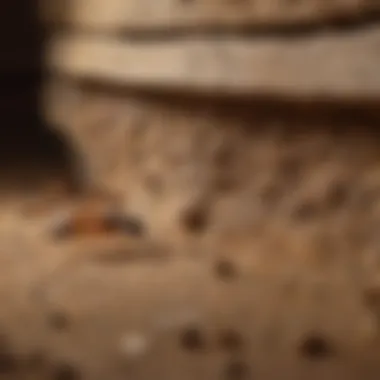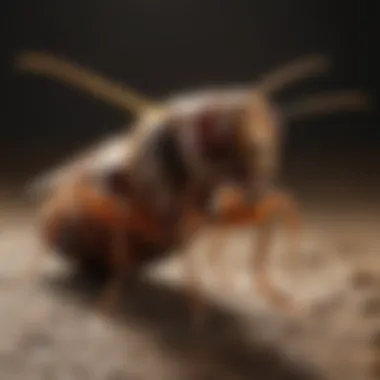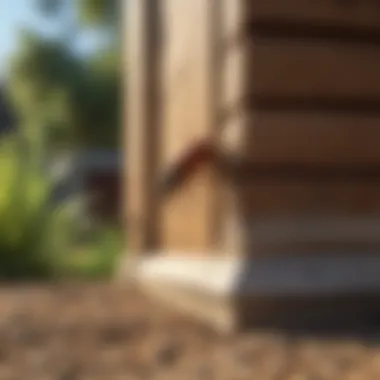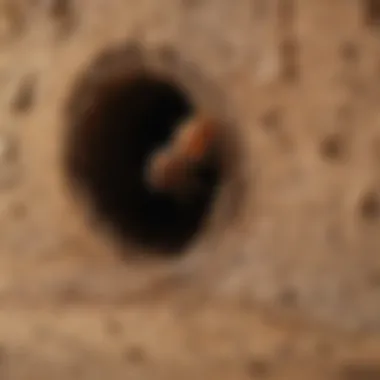Unveiling the Intricacies of Termite and Pest Control: A Detailed Guide


Identifying Pest Risk Areas
Before implementing pest control measures, it is crucial to identify potential risk areas in and around your property where pests might thrive. Conducting thorough inspections of moisture-prone areas is vital to prevent conditions that are conducive to pest infestations. Look for signs of dampness, leaky pipes, or water accumulation, and address these issues promptly to eliminate breeding grounds for pests.
Inspecting crack and crevices in the walls, foundation, and utility entry points is essential. These openings serve as entry points for pests like ants, spiders, and rodents. Sealing off these cracks with caulking or weatherstripping prevents pests from gaining access to your home. Regularly inspecting greenery around your property is also important, as overgrown plants and bushes can create pathways for pests to enter your home. Maintaining a well-groomed yard by trimming vegetation, removing debris, and keeping grass short goes a long way in reducing pest risks.
Other pest risk areas to be mindful of include attics, crawl spaces, and storage areas where pests often seek shelter. Implementing preventative measures in these spaces, such as sealing off entry points, using traps or baits, and installing door sweeps, can help in mitigating the risk of infestations. By staying vigilant and addressing potential risk areas proactively, homeowners can create an environment that is less hospitable to pests.
Introduction to Termite and Pest Control
Presented is an in-depth exploration of the critical realm of termite and pest control, offering invaluable insights and strategic approaches to combat these insidious invaders. Delve into the intricacies of understanding termites, common pest infestations, and the vital importance of pest control in safeguarding properties. This comprehensive guide aims to empower readers with the knowledge and tools necessary to effectively manage and mitigate the risks posed by these destructive forces.
Understanding Termites: Nature's Tiny Destructors
The Biology of Termites
Within the realm of termite biology lies a fascinating complexity that contributes significantly to the pervasive issue of termite infestations. Exploring the unique features of termite biology unveils their social structures, feeding habits, and reproduction cycles, shedding light on why they pose a formidable challenge for property owners. By deciphering the intricacies of termite biology, we can better understand their behavior patterns and implement targeted control strategies to mitigate their impact effectively.
Types of Termites
Termites manifest in varying species, each with distinct characteristics and tendencies that influence their destructiveness. From subterranean termites to drywood termites, comprehending the differences between these types is pivotal in devising tailored prevention and treatment plans. By delineating the nuances between termite species, property owners can identify the specific threats they face and implement preemptive measures accordingly to safeguard their assets.
Damage Caused by Termites
The havoc wreaked by termite infestations spans from structural disintegration to financial burdens, underlining the dire consequences of unchecked termite activity. Understanding the extent of damage caused by termites underscores the urgency of proactive control measures to preserve property integrity and value. By grasping the repercussions of termite-induced destruction, individuals are motivated to prioritize preventative actions and enlist professional assistance to combat these formidable adversaries.
Common Pest Infestations: Identifying the Culprits
Types of Common Pests


An array of common pests infiltrate households, posing diverse threats to both property and health. Understanding the characteristics and habits of prevalent pests such as rodents, cockroaches, and ants is crucial in implementing targeted eradication strategies. By discerning the nuances between pest types, homeowners can effectively address infestations and fortify their living spaces against recurrent invasions.
Signs of Pest Infestations
Detecting early signs of pest infestations is instrumental in mitigating damage and preventing widespread outbreaks. By recognizing indicators like chewed wires, foul odors, or visible droppings, property owners can proactively address pest issues before they escalate. Vigilance in observing pest signatures empowers individuals to take swift and decisive action to curb infestations and minimize associated risks.
Impact of Pests on Property
The detrimental impact of pests on property extends beyond structural damage to encompass health risks and financial liabilities. Unchecked pest infestations jeopardize hygiene standards, compromise structural integrity, and diminish overall property value. Acknowledging the multifaceted consequences of pest presence underscores the necessity of stringent pest control measures to safeguard both residents and investments.
The Importance of Pest Control
Health Risks Posed by Pests
Pests harbor an array of health hazards, from allergens to disease vectors, posing serious threats to human well-being. Understanding the health risks posed by pests underscores the imperative of maintaining pest-free environments to safeguard inhabitants. By prioritizing pest control, homeowners can mitigate these health risks and uphold a safe and hygienic living environment for their families.
Economic Consequences of Infestations
Pest infestations entail substantial economic repercussions, ranging from property damage repair costs to decreased market value. Recognizing the financial toll of pest incursions emphasizes the cost-effectiveness of preventive pest control measures. By investing in proactive pest management, property owners can mitigate financial losses and preserve the long-term value of their assets.
Environmental Impact
The environmental ramifications of pest infestations encompass ecosystem disruptions, pesticide pollution, and biodiversity loss. Assessing the environmental impact of pest control practices is essential in promoting sustainable and eco-conscious pest management solutions. By adopting environmentally friendly pest control approaches, individuals contribute to preserving ecological balance and fostering a healthier coexistence with nature.
Preventive Measures for Termite and Pest Control
In the realm of termite and pest control, preventive measures play a crucial role in safeguarding properties from these invasive creatures. Understanding the significance of proactive steps is paramount in minimizing potential damages and ensuring a pest-free environment within your premises. By implementing effective preventive strategies, homeowners can mitigate the risks associated with termite infestations and pest invasions.
Fortifying Your Property: Effective Prevention Strategies


- Building Design Considerations: When it comes to fortifying your property against termites and pests, incorporating specific building design considerations can significantly enhance protection levels. Certain structural elements, such as using termite-resistant materials or adopting raised foundations, can act as formidable barriers against termite intrusion. Understanding the importance of these design aspects and their contribution to creating a hostile environment for pests is imperative. Employing such building design strategies ensures a long-term defense mechanism against potential threats, making it a popular and wise choice for homeowners looking to fortify their properties.
- Landscaping Tips: The landscape surrounding your home can either attract or deter pests and termites. Implementing landscaping tips that focus on maintenance, such as keeping vegetation trimmed and away from the structure, can reduce attractive habitats for pests. Additionally, selecting plant species known for repelling insects can act as a natural deterrent. Understanding how these landscaping techniques contribute to pest control efforts is essential in creating an inhospitable environment for unwanted intruders.
- Moisture Control Techniques: Moisture control plays a pivotal role in pest prevention, particularly in thwarting termite infestations. Ensuring proper drainage, addressing leaks promptly, and ventilating crawl spaces effectively can help in reducing excess moisture that attracts pests. Implementing moisture control techniques is beneficial in not only deterring pests but also in preventing other structural issues associated with damp environments. Although requiring regular upkeep, these techniques provide a sustainable and effective approach towards maintaining a pest-free home environment.
Professional Termite and Pest Control Services
Professional termite and pest control services play a vital role in safeguarding properties from potential damage caused by these troublesome invaders. By enlisting the expertise of pest control experts, homeowners can benefit from specialized knowledge and efficient solutions tailored to their unique pest issues. These services encompass a range of offerings, including termite inspections, pest identification, treatment plans, and ongoing maintenance. Professional pest control services not only address existing infestations but also focus on preventive measures to mitigate future risks, ensuring long-term property protection.
Hiring a Pest Control Expert: What to Look For
When considering hiring a pest control expert, certifications and licenses hold paramount importance. These credentials assure homeowners of the technician's training and competence in handling various pest control methods safely and effectively. Experience and reputation are equally crucial factors to evaluate when selecting a pest control provider. An experienced expert brings a wealth of knowledge and problem-solving skills to effectively manage pest infestations. A reputable service provider garners trust through positive customer reviews and successful pest control outcomes, indicating reliability and proficiency. Service guarantees further enhance the credibility of a pest control service, assuring homeowners of quality workmanship and customer satisfaction.
Termite Baiting Systems and Treatments
Understanding different types of baiting systems is essential for effective termite management. Baiting systems, such as bait stations and baits containing growth inhibitors, target termites at their source, disrupting their colony's growth and eventual eradication. Chemical treatments offer a more aggressive approach to termite control, utilizing potent substances to eliminate termite populations swiftly. However, it is crucial to consider the environmental impact and potential risks associated with chemical treatments. Monitoring and maintenance of baiting systems and treated areas are imperative for long-term termite control, ensuring continued efficacy and preventing re-infestations.
Regular Inspections and Maintenance
Frequent inspections are the cornerstone of proactive pest management, allowing early detection of pest issues before they escalate. Regular inspections enable timely intervention, minimizing potential damage and treatment costs. Preventive maintenance tips, such as sealing entry points, reducing moisture sources, and trimming vegetation near the property, aid in creating an inhospitable environment for pests. Addressing early infestations promptly is key to preventing pest proliferation and structural damage, underscoring the importance of vigilant monitoring and swift action against potential threats.
Emerging Trends in Termite and Pest Control
Emerging trends in termite and pest control play a vital role in staying ahead of these relentless invaders. As technology and environmental awareness evolve, innovative approaches are reshaping the landscape of pest management. These advancements not only enhance efficacy but also promote sustainability and eco-friendliness in combating termite and pest issues. By embracing these trends, homeowners can achieve long-term solutions that safeguard their properties effectively.
Technological Advancements in Pest Detection
IoT Applications
Io T applications revolutionize pest detection by utilizing smart devices and sensors to monitor pest activity in real time. The key characteristic of IoT applications lies in their ability to provide continuous surveillance and early detection of pest infestations. This proactive approach enhances preventive measures and minimizes the need for reactive treatments. The unique feature of IoT applications is their seamless integration with existing home systems, offering convenience and timely alerts to homeowners. While the advantages of IoT applications include round-the-clock monitoring and data-driven insights for targeted pest control, potential drawbacks may involve initial setup costs and dependency on reliable connectivity.
Remote Monitoring Systems


Remote monitoring systems offer remote access to pest activity data, enabling homeowners to track and manage infestations from anywhere. The key characteristic of these systems is their ability to provide real-time updates and customizable alerts for different types of pests. This feature enhances control measures and empowers homeowners to take swift action against intruders. The unique feature of remote monitoring systems is their user-friendly interface and seamless integration with mobile devices, ensuring accessibility and ease of use. While the benefits of these systems include increased efficiency and convenience in pest management, possible drawbacks may include the reliance on stable internet connectivity and occasional technical issues.
Data Analytics in Pest Management
Data analytics revolutionizes pest management by analyzing trends and patterns to predict and prevent infestations effectively. The key characteristic of data analytics lies in its ability to process large volumes of data to identify potential pest risks and trends. This analytic approach enhances decision-making and enables proactive strategies for pest control. The unique feature of data analytics is its ability to optimize treatment plans and resource allocation based on predictive modeling. While the advantages of data analytics include improved efficiency and targeted interventions, limitations may arise from data accuracy and interpretation challenges.
Eco-Friendly Pest Control Solutions
Eco-friendly pest control solutions promote sustainability and biodiversity while effectively managing pest populations. These methods prioritize environmental preservation and human health, offering a greener alternative to traditional pest control strategies. By harnessing nature's own mechanisms, homeowners can address pest issues without compromising ecosystem integrity.
Biological Control Methods
Biological control methods harness natural predators or pathogens to control pest populations, providing a sustainable and chemical-free approach to pest management. The key characteristic of biological control methods is their ability to target specific pests while minimizing harm to beneficial organisms. This targeted approach ensures effective pest control without adverse environmental impacts. The unique feature of biological control methods is their compatibility with organic farming practices and biodiversity conservation efforts. While the benefits include reduced chemical usage and long-term pest suppression, challenges may arise from variable effectiveness depending on environmental conditions and pest species.
Sustainable Practices
Sustainable practices in pest control emphasize long-term solutions that balance efficacy with environmental stewardship. The key characteristic of sustainable practices is their focus on holistic pest management approaches that address underlying causes of infestations. By promoting ecosystem health and resilience, sustainable practices aim to create pest-resistant environments that deter infestations naturally. The unique feature of sustainable practices is their integration of cultural, biological, and mechanical control methods for comprehensive pest management. While the advantages include reduced reliance on pesticides and enhanced ecosystem services, limitations may stem from initial implementation costs and variability in effectiveness.
Green Pest Management
Green pest management aligns with environmentally friendly practices, focusing on least-toxic methods to control pest populations. The key characteristic of green pest management is its commitment to minimizing chemical exposure and collateral damage to non-target organisms. This proactive approach prioritizes human and environmental health while effectively addressing pest issues. The unique feature of green pest management is its emphasis on preventive measures and habitat modification to deter pests naturally. While the advantages include safer living environments and reduced ecological footprint, challenges may arise from limited immediate control efficacy and the need for consistent monitoring.
Community-Based Pest Control Initiatives
Community-based pest control initiatives foster collaboration and shared responsibility in managing pest issues at a societal level. By engaging communities in pest awareness and control activities, these initiatives aim to create sustainable solutions that benefit all stakeholders.
Collaborative Efforts
Collaborative efforts bring together individuals, organizations, and local authorities to address pest challenges collectively. The key characteristic of collaborative efforts is their emphasis on coordinated action and knowledge sharing to tackle pest issues comprehensively. This collective approach leverages community resources and expertise to implement integrated pest management strategies effectively. The unique feature of collaborative efforts is the synergy achieved through diverse perspectives and unified goals in pest control efforts. While the benefits include increased community resilience and resource optimization, challenges may arise from communication barriers and varying levels of engagement.
Education and Outreach Programs
Education and outreach programs play a vital role in raising awareness and building capacity for pest management within communities. The key characteristic of these programs is their focus on disseminating knowledge and promoting best practices in pest control. By empowering individuals with information and skills, education and outreach programs enable proactive pest prevention and early intervention. The unique feature of these programs is their ability to bridge knowledge gaps and foster a culture of pest awareness and responsibility. While the advantages include improved community readiness and reduced pest-related risks, limitations may stem from resource constraints and sustainability of outreach efforts.
Public Health Partnerships
Public health partnerships engage health authorities and local agencies in collaborative pest control efforts to safeguard public health and well-being. The key characteristic of these partnerships is their focus on addressing pest-related health risks and promoting disease prevention through integrated approaches. By aligning public health objectives with pest management strategies, these partnerships enhance community resilience and health outcomes. The unique feature of public health partnerships is their interdisciplinary approach, integrating medical, environmental, and pest control expertise for comprehensive solutions. While the benefits include improved disease surveillance and response capabilities, challenges may arise from resource allocation disparities and jurisdictional overlaps.



